Voltage gating of Shaker K+ channels. The effect of temperature on ionic and gating currents
- PMID: 9689029
- PMCID: PMC2525751
- DOI: 10.1085/jgp.112.2.223
Voltage gating of Shaker K+ channels. The effect of temperature on ionic and gating currents
Abstract
Ionic (Ii) and gating currents (Ig) from noninactivating Shaker H4 K+ channels were recorded with the cut-open oocyte voltage clamp and macropatch techniques. Steady state and kinetic properties were studied in the temperature range 2-22 degreesC. The time course of Ii elicited by large depolarizations consists of an initial delay followed by an exponential rise with two kinetic components. The main Ii component is highly temperature dependent (Q10 > 4) and mildly voltage dependent, having a valence times the fraction of electric field (z) of 0.2-0.3 eo. The Ig On response obtained between -60 and 20 mV consists of a rising phase followed by a decay with fast and slow kinetic components. The main Ig component of decay is highly temperature dependent (Q10 > 4) and has a z between 1.6 and 2.8 eo in the voltage range from -60 to -10 mV, and approximately 0.45 eo at more depolarized potentials. After a pulse to 0 mV, a variable recovery period at -50 mV reactivates the gating charge with a high temperature dependence (Q10 > 4). In contrast, the reactivation occurring between -90 and -50 mV has a Q10 = 1.2. Fluctuation analysis of ionic currents reveals that the open probability decreases 20% between 18 and 8 degreesC and the unitary conductance has a low temperature dependence with a Q10 of 1.44. Plots of conductance and gating charge displacement are displaced to the left along the voltage axis when the temperature is decreased. The temperature data suggests that activation consists of a series of early steps with low enthalpic and negative entropic changes, followed by at least one step with high enthalpic and positive entropic changes, leading to final transition to the open state, which has a negative entropic change.
Figures
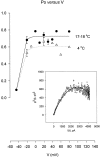
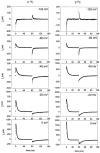



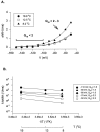


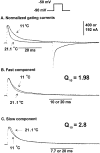

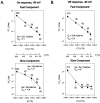

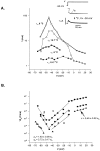



Similar articles
-
Coupling between charge movement and pore opening in voltage dependent potassium channels.Medicina (B Aires). 1995;55(5 Pt 2):591-9. Medicina (B Aires). 1995. PMID: 8842189
-
Gating of Shaker K+ channels: I. Ionic and gating currents.Biophys J. 1994 Apr;66(4):996-1010. doi: 10.1016/S0006-3495(94)80881-1. Biophys J. 1994. PMID: 8038403 Free PMC article.
-
Gating of Shaker K+ channels: II. The components of gating currents and a model of channel activation.Biophys J. 1994 Apr;66(4):1011-21. doi: 10.1016/S0006-3495(94)80882-3. Biophys J. 1994. PMID: 8038375 Free PMC article.
-
Gating of voltage-dependent potassium channels.Prog Biophys Mol Biol. 2001;75(3):165-99. doi: 10.1016/s0079-6107(01)00006-2. Prog Biophys Mol Biol. 2001. PMID: 11376798 Review.
-
Voltage and Temperature Gating of ThermoTRP Channels.In: Liedtke WB, Heller S, editors. TRP Ion Channel Function in Sensory Transduction and Cellular Signaling Cascades. Boca Raton (FL): CRC Press/Taylor & Francis; 2007. Chapter 21. In: Liedtke WB, Heller S, editors. TRP Ion Channel Function in Sensory Transduction and Cellular Signaling Cascades. Boca Raton (FL): CRC Press/Taylor & Francis; 2007. Chapter 21. PMID: 21204490 Free Books & Documents. Review.
Cited by
-
Turning a Kv channel into hot and cold receptor by perturbing its electromechanical coupling.bioRxiv [Preprint]. 2024 Aug 9:2024.08.08.607202. doi: 10.1101/2024.08.08.607202. bioRxiv. 2024. Update in: Nat Commun. 2025 Apr 9;16(1):3379. doi: 10.1038/s41467-025-58443-9. PMID: 39149297 Free PMC article. Updated. Preprint.
-
ENaC-membrane interactions: regulation of channel activity by membrane order.J Gen Physiol. 2004 Jun;123(6):709-27. doi: 10.1085/jgp.200308983. Epub 2004 May 17. J Gen Physiol. 2004. PMID: 15148329 Free PMC article.
-
Temperature dependence and thermodynamic properties of Ca2+ sparks in rat cardiomyocytes.Biophys J. 2005 Oct;89(4):2533-41. doi: 10.1529/biophysj.105.067074. Epub 2005 Aug 19. Biophys J. 2005. PMID: 16113119 Free PMC article.
-
Principles of conduction and hydrophobic gating in K+ channels.Proc Natl Acad Sci U S A. 2010 Mar 30;107(13):5833-8. doi: 10.1073/pnas.0911691107. Epub 2010 Mar 15. Proc Natl Acad Sci U S A. 2010. PMID: 20231479 Free PMC article.
-
Probability fluxes and transition paths in a Markovian model describing complex subunit cooperativity in HCN2 channels.PLoS Comput Biol. 2012;8(10):e1002721. doi: 10.1371/journal.pcbi.1002721. Epub 2012 Oct 18. PLoS Comput Biol. 2012. PMID: 23093920 Free PMC article.
References
-
- Aggarwal SK, MacKinnon R. Contribution of the S4 segment to gating charge in the Shaker K+channel. Neuron. 1996;16:1169–1177. - PubMed
Publication types
MeSH terms
Substances
Grants and funding
LinkOut - more resources
Full Text Sources
Other Literature Sources

